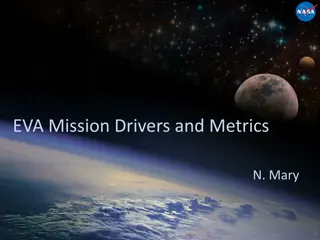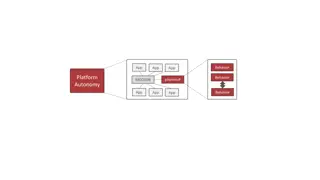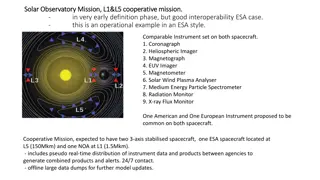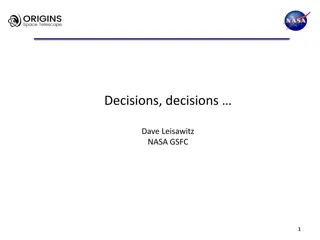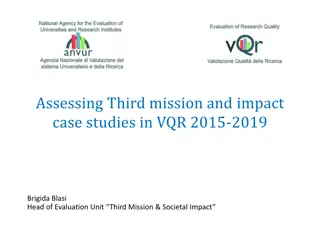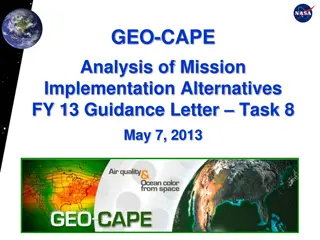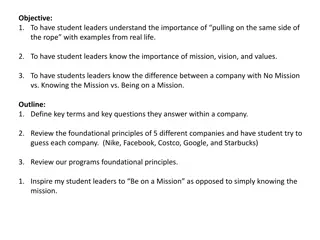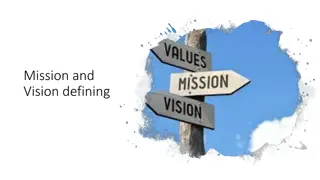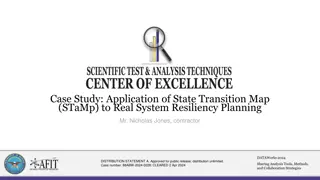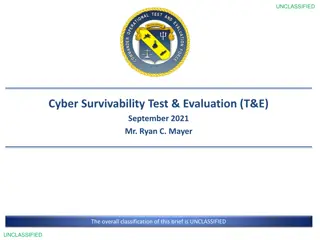uConserve Impact Potential and Mission Overview
WiserResources' uConserve dashboard aims to drive awareness and conservation of natural resources through analytics and actionable recommendations. The dashboard enables users to monitor and adjust their resource consumption habits, potentially leading to significant reductions in power and water usage.
Download Presentation

Please find below an Image/Link to download the presentation.
The content on the website is provided AS IS for your information and personal use only. It may not be sold, licensed, or shared on other websites without obtaining consent from the author. Download presentation by click this link. If you encounter any issues during the download, it is possible that the publisher has removed the file from their server.
E N D
Presentation Transcript
WiserResources uConserve Dashboard Project Update July 6th, 2015 Rahul Bansal Lisa Kirch Nital Patwa
Roadmap for Discussion 1. Projects Goals and Potential Impact 1. Product Research and Design 1. Update on Project Plan o Current Status o Next Steps o Group Needs
The Firms Mission At WiserResources, our mission is to drive awareness and conservation of the world s natural resources through compelling analytics, insightful visualizations, and targeted, actionable conservation recommendations.
Bringing the Mission to Life The uConserve dashboard is the manifestation of our mission in the form of a web application that allows users to see, understand, and intelligently change their resource consumption habits uConserve shows our consumers their usage across all three resources - electricity, water, and natural gas - in one convenient location Founded on research in behavioral science on the most effective ways of inflecting behavioral change o Incentives Monetary Emotional o Meaningful Comparisons o Competition o Personal pledges and goal setting
uConserve Impact Potential Driving a 5% reduction in power consumption will have a significant effect Opportunity in Electricity Population Avg Yr Consumption / Home % Reduction Yearly Energy Savings Power # Vehicles for One Year Power # Homes for One Year Pilot - 152 homes 0.11 gWh 16 7.6 14,500 kWh 5% Austin ~350,000 homes 253.75 gWh*** 36,000 17,500 *** Equivalent to 175,000 Metric Tons CO2
uConserve Impact Potential Austin Water is asking residents to pledge a 10% reduction. Here is the impact on just 5%. Opportunity in Water Population Daily usage per capita % Reduction Yearly Water Savings Pilot - approx 600 residents 1.5 M gallons 136 gallons 5% Austin - 1M+ residents 2.4 B gallons*** *** Equivalent to 3,760 Olympic size swimming pools
Key Takeaways from our Research A few founding principles based on our evaluation of a small portion of published research on behavioral change. Households presented with frequent usage information are significantly more responsive to price changes and decreased energy usage by 11-14% Voluntary consumer-oriented programs can reduce household carbon footprints by 5-20% Pledges have long-term effects Behavior change is frequently motivated more by peer pressure than virtue or self-interest Better to emphasize a few key behaviors rather than presenting long lists of possible changes
Following an Average Users Thought Process Our theory for how a user would start to learn about, trust, and use data through uConserve. Understand your data first Explore comparisons with meaningful comparison groups Implement, track progress against usage reduction recommendations Simple usage graphs Summary statistics Appliance breakdown Start with city-wide comparisons (eg. across Austin, TX) Build groups based on house size, age, # of residents Overlay usage patterns of similar users AC setting recommendation based on weather End-of-month bill prediction, highlight potential savings Facilitate competition and user-specific pledges Emotionally compelling equivalencies between usage and environmental impact
Dashboards on the Market Bidgely Google s PowerMeter PG & E GE Green Button Data OPower
How are we different? Several utility companies as well as downstream analytics companies have released applications that try to inform consumers about their resource consumption. What differentiates uConserve? First application to blend resource consumption across all three utilities Allow users to delve deep into their data Meaningful, apples-to-apples comparisons and benchmarks Natural weather/temperature overlay End-of-month bill prediction Facilitate friendly competition as well as self-fulfillment through pledges
Which Appliances Dominate Usage? 400W PC, TV, Lights Dip 1000W 4500W AC
Your Usage During a Day Winter Could You Recognize This Usage at noon? Summer AC is ON Continuously
Our Progress ITERATIVE TESTING Planning Research Analysis UX Launch Today June 8th August 17th On track to hit August 17th launch goal based on current scope and pacing Foundational research completed shortly after checkpoint #1 on June 8th o Survey of existing literature on behavior change in energy consumption o Incorporating early feedback from faculty and peers around feasibility and scope Currently iterating on analyses and compelling visualizations o Driving to be impactful and engaging from the very first use No immediate needs from WiserResources Executive Team
Q & A WiserResources
Data Sources Cost of electricity per kwh, cost of water per cubic foot, cost of gas per thousand cubic feet provided by Pecan Street Dataport - disaggregated electricity, gas, and water data at the minute level (2013-2014) Sub-circuit data to assist labeling - broken out into washer/dryer, dishwasher, furnace, AC, refrigerator, water heater, indoor and outdoor plugs Survey data - house size, # floors, # rooms, age, # residents Appliance audits - manufacturer, model, age, power (BTUs) Census data Weather data
Minimum Viable Product ---- what needs to be in our product that reflect our learnings from research Use fine-grained, per-household data for electricity, gas, and water Perform time-series, component, and behavioral analysis Create actionable insights for the home owner Allow the homeowner to make pledges to reduce resource usage Develop basic visualization framework to deliver results and recommendations
Illustrative Displays Your Power Usage is Highest During Evening Hours Your Power Usage is Higher During Weekends
Daily Usage Time Series Winter Spring 0.5 0.5 Summer Fall 3 0.5 0.5
Behavior Extraction Post-dinner 9- 10pm Post-Dinner 9- 10PM Why Gap?
Summer Day Usage (08/01/13) Natural Cooling Heavy Usage From?
Per-Minute Usage Histogram Quad-Modal Distribution Centered at 0.5, 3, 6 and 8 W-H/Min Contribution to yearly usage: 61%, 32%, 5%, 0.5% 61.5% 32.5% 5.35% 6 0.5% 8 2 4



